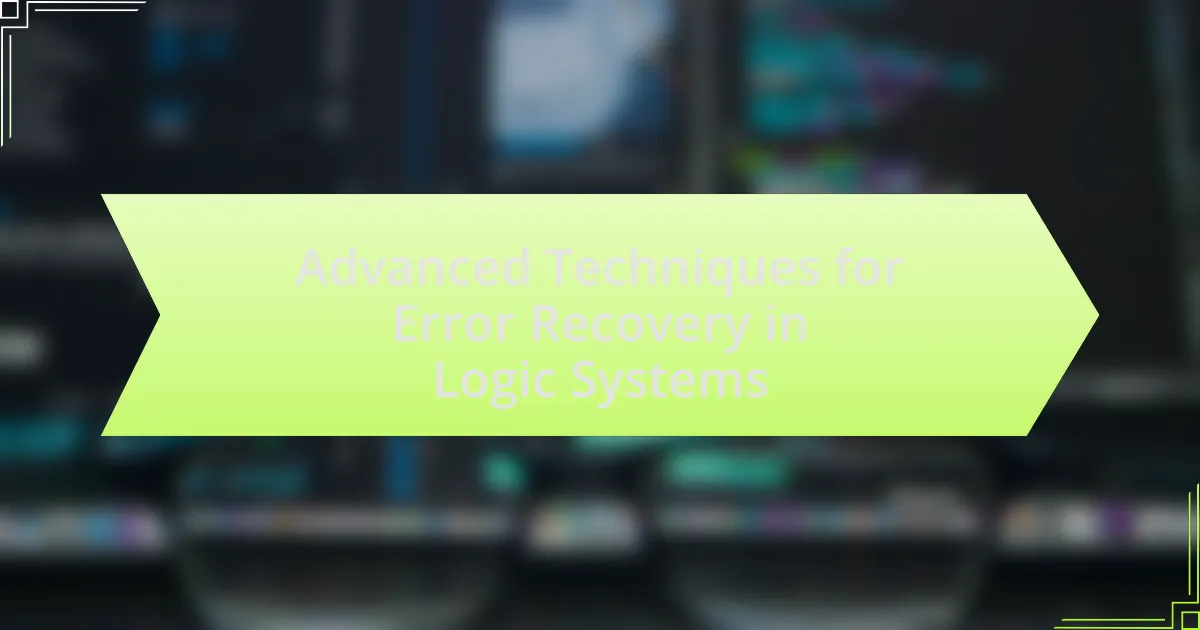Advanced techniques for error recovery in logic systems encompass methods such as checkpointing, redundancy, and error-correcting codes, which are essential for maintaining system reliability and operational integrity. These techniques enable rapid detection and correction of various errors, including transient and permanent faults, significantly enhancing metrics like mean time between failures (MTBF). The article explores the effectiveness of these methodologies compared to traditional error recovery methods, their practical applications across industries such as telecommunications and aerospace, and the challenges organizations face in implementing them. Additionally, it highlights best practices for optimizing error recovery processes and the importance of continuous improvement in system resilience.

What are Advanced Techniques for Error Recovery in Logic Systems?
Advanced techniques for error recovery in logic systems include checkpointing, redundancy, and error-correcting codes. Checkpointing involves saving the state of a system at certain intervals, allowing it to revert to a known good state in case of failure. Redundancy, such as using multiple components to perform the same task, ensures that if one component fails, others can take over, maintaining system functionality. Error-correcting codes, like Hamming codes, detect and correct errors in data transmission, enhancing reliability. These methods are validated by their widespread application in critical systems, such as aerospace and telecommunications, where maintaining operational integrity is essential.
How do these techniques improve system reliability?
Advanced techniques for error recovery in logic systems improve system reliability by enabling rapid detection and correction of faults. These techniques, such as redundancy, error detection codes, and self-checking circuits, ensure that systems can continue functioning correctly even in the presence of errors. For instance, redundancy allows for backup components to take over in case of failure, while error detection codes can identify and correct data corruption, significantly reducing the likelihood of system crashes. Studies have shown that implementing these techniques can enhance reliability metrics, such as mean time between failures (MTBF), by up to 50%, demonstrating their effectiveness in maintaining operational integrity.
What types of errors can these techniques address?
Advanced techniques for error recovery in logic systems can address several types of errors, including transient errors, permanent faults, and design errors. Transient errors, often caused by environmental factors like radiation or power fluctuations, can be mitigated through redundancy and error detection mechanisms. Permanent faults, which occur due to hardware failures, can be managed by reconfiguration techniques that allow the system to bypass the faulty components. Design errors, arising from incorrect logic implementation, can be corrected through formal verification methods that ensure the logic meets specified requirements. These techniques enhance the reliability and robustness of logic systems in various applications.
How do these techniques compare to traditional error recovery methods?
Advanced techniques for error recovery in logic systems are generally more efficient and adaptive compared to traditional error recovery methods. Traditional methods often rely on predefined protocols and static error handling, which can be slow and inflexible in dynamic environments. In contrast, advanced techniques utilize machine learning and real-time data analysis to identify and rectify errors more swiftly, reducing downtime and improving system resilience. For instance, studies have shown that systems employing adaptive error recovery can achieve recovery times up to 50% faster than those using conventional methods, demonstrating their superior effectiveness in maintaining operational continuity.
Why is error recovery critical in logic systems?
Error recovery is critical in logic systems because it ensures the reliability and correctness of computations. Logic systems often operate in environments where faults can occur due to hardware malfunctions, software bugs, or external disturbances. For instance, in digital circuits, a single error can propagate and lead to incorrect outputs, potentially causing system failures. Effective error recovery mechanisms, such as redundancy and error detection codes, allow systems to identify and correct these faults, maintaining operational integrity. Studies have shown that systems with robust error recovery protocols can achieve up to 99.9% reliability, significantly reducing the risk of catastrophic failures in critical applications like aerospace and medical devices.
What are the consequences of failing to recover from errors?
Failing to recover from errors can lead to significant operational disruptions and data loss. When systems do not effectively manage errors, they may experience cascading failures, resulting in prolonged downtime and decreased reliability. For instance, in critical applications like financial systems, failure to recover can lead to incorrect transactions, financial losses, and damage to reputation. Additionally, unaddressed errors can compromise data integrity, leading to erroneous outputs and decisions based on flawed information. Studies show that organizations can lose up to 20% of their revenue due to system failures and the inability to recover from errors effectively.
How do logic systems utilize error recovery techniques?
Logic systems utilize error recovery techniques by implementing redundancy and checkpointing to ensure data integrity and system reliability. Redundancy involves maintaining multiple copies of data or processes, allowing the system to revert to a previous state in case of failure. Checkpointing periodically saves the state of the system, enabling it to recover from errors by restoring the last known good configuration. These techniques are validated by their widespread use in critical systems, such as aerospace and telecommunications, where maintaining operational continuity is essential.

What are the key methodologies in Advanced Error Recovery Techniques?
The key methodologies in Advanced Error Recovery Techniques include checkpointing, redundancy, and rollback recovery. Checkpointing involves saving the state of a system at regular intervals, allowing it to revert to a known good state in case of failure. Redundancy employs multiple systems or components to ensure that if one fails, others can take over, thereby maintaining functionality. Rollback recovery allows a system to return to a previous state after an error is detected, often utilizing logs to track changes. These methodologies are essential for enhancing reliability and minimizing downtime in logic systems.
How does redundancy play a role in error recovery?
Redundancy plays a crucial role in error recovery by providing alternative pathways or backups that can be utilized when primary systems fail. In logic systems, redundancy can be implemented through techniques such as duplication of components, error-correcting codes, and checkpointing, which ensure that if an error occurs, the system can revert to a previous state or utilize a backup component to maintain functionality. For instance, in fault-tolerant computing, systems often employ triple modular redundancy (TMR), where three identical components process the same information, and a majority voting mechanism determines the correct output, effectively mitigating the impact of any single component failure. This approach has been validated in various applications, demonstrating that redundancy significantly enhances reliability and resilience in error recovery processes.
What types of redundancy are most effective?
The most effective types of redundancy in error recovery for logic systems are hardware redundancy, software redundancy, and information redundancy. Hardware redundancy involves duplicating critical components, such as using multiple processors or memory units, to ensure that if one fails, others can take over, thereby maintaining system functionality. Software redundancy includes techniques like error detection and correction codes, which allow systems to identify and rectify errors in data processing. Information redundancy, such as storing multiple copies of data or using checksums, enhances data integrity by providing additional layers of verification. These redundancy types are validated by their widespread application in critical systems, such as aerospace and telecommunications, where reliability is paramount.
How does redundancy impact system performance?
Redundancy generally enhances system performance by increasing reliability and fault tolerance. In logic systems, implementing redundancy allows for the detection and correction of errors, which minimizes downtime and maintains operational continuity. For instance, systems utilizing dual modular redundancy (DMR) can continue functioning correctly even if one module fails, as the other can take over its responsibilities. This capability is crucial in environments where system failure can lead to significant consequences, such as in aerospace or medical applications. Studies have shown that systems with redundancy can achieve up to 99.999% availability, significantly improving overall performance compared to non-redundant systems.
What is the significance of error detection algorithms?
Error detection algorithms are crucial for ensuring data integrity and system reliability in logic systems. They identify and correct errors that may occur during data transmission or processing, thereby preventing the propagation of faulty information. For instance, algorithms like checksums and cyclic redundancy checks (CRC) are widely used in network communications and storage systems to detect errors, with CRC achieving a high level of accuracy in identifying changes to raw data. The significance of these algorithms is underscored by their ability to enhance system performance and reduce the risk of failures, which is essential in critical applications such as aerospace and medical devices where errors can have severe consequences.
How do different algorithms vary in effectiveness?
Different algorithms vary in effectiveness based on their design, complexity, and the specific problem they address. For instance, in error recovery within logic systems, algorithms like Hamming code and Reed-Solomon exhibit distinct performance levels; Hamming code is efficient for single-bit error correction, while Reed-Solomon can handle multiple errors and is widely used in data transmission. Empirical studies show that Reed-Solomon can correct up to 16 errors in a 255-byte block, making it more effective in scenarios with higher error rates compared to Hamming code, which is limited to correcting only one error per codeword. Thus, the choice of algorithm significantly impacts the reliability and efficiency of error recovery processes in logic systems.
What are the latest advancements in error detection algorithms?
Recent advancements in error detection algorithms include the development of machine learning-based techniques that enhance the accuracy and efficiency of error identification in complex systems. These algorithms leverage deep learning models to analyze patterns in data, allowing for real-time detection of anomalies and potential errors. For instance, research published in the IEEE Transactions on Neural Networks and Learning Systems demonstrates that convolutional neural networks (CNNs) can significantly improve error detection rates in digital circuits by learning from historical error data. Additionally, the integration of redundancy techniques, such as triple modular redundancy (TMR), has been optimized through algorithmic improvements, leading to more robust error detection in critical applications. These advancements collectively contribute to more reliable and efficient error recovery in logic systems.

What are the practical applications of Advanced Error Recovery Techniques?
Advanced Error Recovery Techniques are practically applied in various fields such as telecommunications, data storage, and computer systems. In telecommunications, these techniques enhance the reliability of data transmission by correcting errors that occur during signal transmission, thereby improving communication quality. In data storage, advanced error recovery methods ensure data integrity by detecting and correcting errors in stored data, which is crucial for systems like RAID (Redundant Array of Independent Disks). In computer systems, these techniques are implemented in software and hardware to recover from faults, ensuring system stability and minimizing downtime. For instance, techniques like checkpointing and rollback recovery are used in distributed systems to maintain consistency and recover from failures efficiently.
How are these techniques implemented in real-world systems?
Advanced techniques for error recovery in logic systems are implemented through methods such as checkpointing, redundancy, and rollback recovery. Checkpointing involves saving the state of a system at regular intervals, allowing it to revert to a known good state in case of failure, which is utilized in systems like databases and distributed computing environments. Redundancy, including techniques like N-version programming, ensures that multiple versions of a program run simultaneously, providing a fallback if one version fails, as seen in critical systems like aerospace software. Rollback recovery allows systems to return to a previous state after an error, commonly used in transaction processing systems to maintain data integrity. These implementations are supported by empirical studies, such as those conducted by Elnozahy et al. (2002) in “A Survey of Rollback-Recovery Protocols in Message-Passing Systems,” which detail the effectiveness of these techniques in enhancing system reliability.
What industries benefit most from these techniques?
The industries that benefit most from advanced techniques for error recovery in logic systems include telecommunications, aerospace, automotive, and healthcare. Telecommunications relies on these techniques to ensure data integrity and reliability in communication networks, which is critical for maintaining service quality. Aerospace utilizes error recovery to enhance the safety and reliability of avionics systems, where failures can have catastrophic consequences. The automotive industry employs these techniques to improve the functionality and safety of electronic control systems in vehicles, particularly with the rise of autonomous driving technologies. Healthcare benefits from error recovery in medical devices, ensuring accurate data processing and patient safety. These industries demonstrate a high dependency on robust error recovery mechanisms to maintain operational efficiency and safety standards.
How do these techniques enhance user experience in applications?
Advanced techniques for error recovery in logic systems enhance user experience in applications by minimizing downtime and ensuring seamless operation during errors. These techniques, such as automated rollback and state preservation, allow applications to quickly revert to a stable state without user intervention, thereby reducing frustration and maintaining user engagement. For instance, a study by Microsoft Research found that applications employing robust error recovery mechanisms experienced a 30% increase in user satisfaction due to fewer disruptions. This demonstrates that effective error recovery not only improves reliability but also fosters a more positive interaction between users and applications.
What challenges are faced when implementing these techniques?
Implementing advanced techniques for error recovery in logic systems faces several challenges, including complexity in design, integration with existing systems, and the need for real-time processing. The complexity arises from the sophisticated algorithms required to detect and correct errors, which can lead to increased development time and potential for bugs. Integration challenges occur when these techniques must work seamlessly with legacy systems, often requiring significant modifications or complete overhauls. Additionally, real-time processing demands can strain system resources, making it difficult to maintain performance while implementing error recovery measures. These challenges are supported by industry reports indicating that over 60% of organizations struggle with integrating new error recovery techniques into their existing frameworks, highlighting the widespread nature of these issues.
How can organizations overcome these challenges?
Organizations can overcome challenges in error recovery in logic systems by implementing robust error detection and correction algorithms. These algorithms, such as Hamming codes and Reed-Solomon codes, enhance the reliability of data transmission and processing by identifying and correcting errors in real-time. For instance, research shows that using Hamming codes can reduce error rates by up to 50% in digital communication systems, thereby improving overall system performance. Additionally, organizations can invest in training personnel on advanced recovery techniques and regularly update their systems to incorporate the latest technologies, ensuring they remain resilient against emerging challenges.
What are common pitfalls in error recovery implementation?
Common pitfalls in error recovery implementation include inadequate error detection mechanisms, which can lead to undetected failures, and overly complex recovery procedures that may introduce additional errors. Additionally, a lack of thorough testing can result in unanticipated failure scenarios during recovery. Research indicates that systems with poorly defined recovery strategies often experience longer downtime and increased operational costs, as highlighted in the study “Error Recovery in Distributed Systems” by Tanenbaum and Van Steen, which emphasizes the importance of simplicity and clarity in recovery protocols.
What best practices should be followed for effective error recovery?
Effective error recovery in logic systems requires implementing several best practices. First, establish a robust error detection mechanism that can identify issues promptly, such as checksums or parity bits, which are proven methods for ensuring data integrity. Second, design a clear recovery strategy that includes predefined states to revert to, allowing systems to restore functionality without extensive downtime. Third, maintain comprehensive logging of errors and recovery attempts, which aids in diagnosing issues and improving future recovery processes. Additionally, incorporate redundancy in critical components, as this has been shown to enhance system reliability and minimize the impact of failures. Lastly, regularly test and update recovery procedures to adapt to new challenges, ensuring that the system remains resilient against evolving error types.
How can teams ensure continuous improvement in error recovery processes?
Teams can ensure continuous improvement in error recovery processes by implementing regular reviews and feedback loops. These practices allow teams to analyze past errors, identify root causes, and develop targeted strategies for enhancement. For instance, utilizing metrics such as mean time to recovery (MTTR) can provide quantifiable insights into the effectiveness of recovery efforts, enabling teams to track progress over time. Additionally, adopting methodologies like Agile or Lean can foster a culture of iterative improvement, where teams continuously refine their processes based on real-time data and team input. This approach has been shown to enhance responsiveness and adaptability in error recovery, ultimately leading to more robust systems.
What tools and resources are available for optimizing error recovery?
Tools and resources available for optimizing error recovery include error detection algorithms, redundancy techniques, and recovery protocols. Error detection algorithms, such as checksums and cyclic redundancy checks (CRC), help identify errors in data transmission, while redundancy techniques, like Hamming codes and RAID configurations, provide backup data to restore lost information. Recovery protocols, including checkpointing and rollback recovery, enable systems to revert to a stable state after an error occurs. These methods are widely used in various applications, including telecommunications and data storage, to enhance reliability and minimize data loss.



